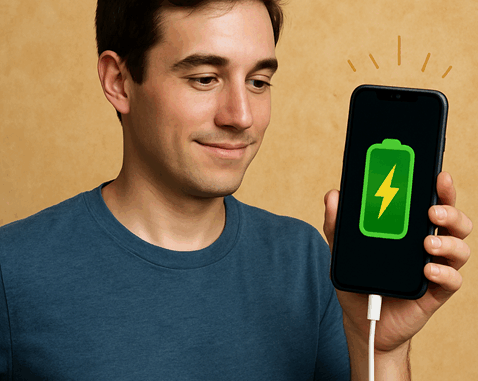
by Larry Magid
This post first appeared in the Mercury News
A 2023 YouGov survey found that battery life was the most important feature when selecting a smartphone. Even though battery life has been improving, I’ve heard from a lot of people who have trouble getting through a full day without having to recharge their phone. That’s certainly been my experience, especially on busy days when I need to use my phone a lot and am away from a charger, such as when I’m traveling.
When possible, my first recommendation is to charge when you can. I put my phone on a magnetic charger when I’m sitting at my desk and charge it while I sleep. I also try to plug it in when I’m in the car and keep a charger with a long cord by the couch where my wife and I often sit at night. I have a portable charger that does the trick when on hikes or bike rides, but I usually forget to bring it along. I do carry it with me when I travel, because that’s when I typically use my phone for walking directions and am often not near an electrical outlet.
Saving energy
Reducing screen brightness can have a big impact, but it can also make the phone harder to use. I typically set it at about 60% but tweak it at times when I need a brighter screen. Another option is to let the phone automatically adjust brightness depending on ambient light, though I sometimes find that it dims my phone a bit too much.
Setting the phone to dark mode can also save energy. Some people love dark mode, but I’m not a fan, so I skip that option except when I’m in situations where battery life is critical.
App power consumption and background use
One place to start your hunt for energy efficiency is to look at what apps are using the most power. On iPhones, you go to Settings, search “battery” and scroll down to “battery usage by app.” It will not only tell you what percentage of your battery was used by each app but also whether it was background activity. On Android, you search for Battery Usage. It, too, will show the percentage and number of background minutes.
With many apps, you can save energy by turning off background app refresh, but be careful. Don’t do this with any app whose notifications are important, such as your messaging apps, email, navigation or notification apps for alarms, your HVAC system, etc.
Also, don’t disable background refresh for health and fitness apps that monitor you, apps associated with wearables or ones that unlock your car or house when you’re nearby. You might also want to keep apps that upload data in the background, such as file sharing or photo apps.
But you likely have plenty of apps that never need to run in the background. I don’t mind, for example, waiting a few seconds for news apps to update. I personally have no interest in alerts when a friend updates their social media feed or my shopping apps notify me about a sale.
I disabled background refresh for most of my iPhone apps, and it made a very big difference. I can now get through a day without having to recharge.
Not necessary to close apps
In most cases, it’s not necessary to close apps that you’re not using because both Android and iOS are designed to pause apps in the background, using minimal resources. Some argue that it can even be counterproductive, because you use energy if you reload them. But there are some apps that can hog energy while in use, such as navigators constantly accessing the GPS system. Closing them might not turn off GPS, so make sure, for example, that you’re keeping Google Maps in navigation mode unless you’re actually using it.
Turning off services you don’t need
Your phone has several radios that you may not always need. Turning them off can save energy. Except on airplanes, I never turn off cellular, but if I’m away from home or anywhere I don’t need Wi-Fi, I’ll turn that off if I need to save energy and turn it back on again when needed. I rarely turn off Bluetooth because I need it for my watch and to start my car, but if you don’t need it, turning it off can save energy. Using a VPN (virtual private network) can protect your privacy, but it also uses energy.
Low-power mode
Both iOS and Android offer battery saver modes that adjust settings to extend battery life. Going into low-power mode may turn off some services, reduce screen brightness or slow down response time so use this only when necessary. For iOS, search Settings for Low Power Mode and for Android search for Battery Saver.
External battery
While it’s one more thing to carry, having a portable external battery charger should be able to keep your phone going all day. They come in various capacities, prices and weights but one with a 5,000 mAh battery should be adequate to fully recharge most phones.
And there’s one more thing that will extend the phone’s battery and, with hope, recharge yours. Put the phone down or keep it in your pocket to give it — and you — a bit of rest.